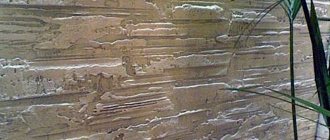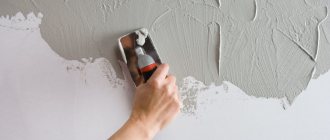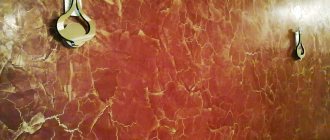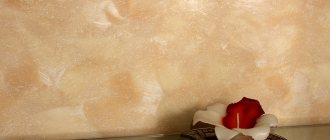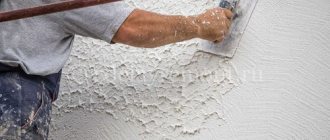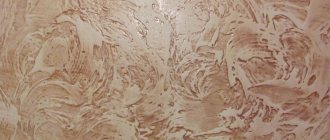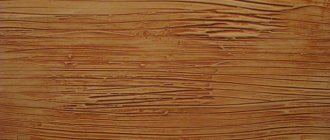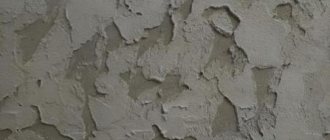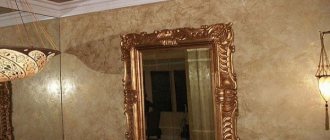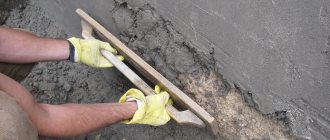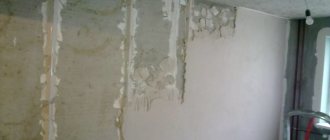Wall decoration with decorative plaster has gained popularity over the past 5 years. At the same time, applying decorative plaster is considered a complex process that cannot be done independently, and hiring a professional is expensive because the cost varies from 700 to 1,500 rubles. for 1m2. In fact, this is not so, all the work can be done without hiring hired specialists, and the result obtained will be no worse.
By choosing a decorative coating as a finishing material, you will give your home a unique design that will compare favorably with traditional renovation methods. Remember that, despite the beauty, this finish has its pros and cons.
The advantages include:
- Easy to clean;
- The design will be very impressive and 100% individual;
- The coating is durable;
- Requires minimal care;
- Not afraid of strong temperature changes;
- Some types of structural mortars act as an additional layer of insulation;
- Most materials are environmentally friendly;
- Some types of finishing will help hide the imperfections of the walls.
The disadvantages of using are:
- High cost (applies only to some mixtures);
- Some compositions require good preliminary preparation of the walls;
- Complexity of application compared to traditional repair methods;
- Lengthy and labor-intensive replacement process.
If these disadvantages are not critical, such repairs will be an excellent choice for both an apartment and a private house.
If you have no experience working with decorative materials yourself, it is recommended to practice beforehand. This can be done on pieces of drywall or plywood.
Types and methods of applying decorative plaster with your own hands.
Today, many types of decorative plaster are produced for wall decoration. Each of them has its own special options for applying plaster. But the surface preparation technology, the main part of the tool and the painting technology are the same.
To tell the reader how the technique of applying decorative coatings differs, let’s look at their main varieties.
Textured.
These decorative compositions include mixtures that give a unique relief on the wall when using a special tool (for example, structural rollers), the relief can also be obtained using special installation techniques (for example, decorative plaster world map). The movements of the master's hand in combination with the use of a special tool will create the desired patterns.
Structural.
For structural mixtures it is not necessary to use a special tool or special technique. An extraordinary relief is obtained due to the fillers included in the composition. Granite and marble chips, mineral inclusions, fibers of various fabrics and more are used as filler. Using a spatula and trowel, apply one layer to the surface, after the first layer has dried, use the trowel again to create a pattern. There are also marble plasters that create a stone shell of walls entirely consisting of particles of this noble stone.
Venetian.
This type of decorative plaster will give the house the real luxury of a Roman mansion. This wall covering imitates natural stone, most often marble, granite, malachite, etc. Before applying the composition, be sure to practice on sheets of drywall. The application process will be described separately because... is complex and a brief description will not be helpful.
Bas-relief
In the article, by bas-relief we will understand all types of sculptural images made using gypsum or other types of plaster and receding from the plane of the base to a short distance. Such work is carried out with subsequent decoration. If you feel the strength and talent to choose a bas-relief as a decoration, the efforts spent will be returned a hundredfold.
Choosing one of the listed types is difficult, but necessary, because the future method of application will depend on this choice.
Structural
A ready-made material with a base of acrylic or silicate resins is offered for sale. Marble and quartz chips are used as filler, resulting in a grainy structure.
This is a universal, mechanically resistant coating. Applying decorative plaster with your own hands is quite simple; as a result, an original relief is formed.
The resulting layer is characterized by high parameters of breathability and moisture resistance. At the same time, temperature fluctuations do not have a significant impact on quality.
To apply the material you need:
- clean the area;
- dry the wall;
- if necessary, level the surface;
- prime the wall and apply plaster.
Technology of applying decorative plaster to walls.
Now you know that application methods greatly depend on the choice of decorative plaster, but the general principles will be the same for all coatings. This part describes a simple procedure for applying all types of coatings to walls with your own hands.
The mixtures can be ready-made, dry or prepared independently. Depending on your desire, you can choose any of the above, the main thing is to strictly follow the manufacturer’s instructions when preparing and maintain all specified time intervals.
General technology step by step:
- Preparation. An important stage of work, regardless of the chosen mixture. Decorative finishing serves only to decorate the walls and is not intended to align them. Before proceeding to the main stage, level the wall using a cement-sand mixture. To ensure good adhesion, prime the surface. The only thing that requires perfect alignment of the walls is Venetian plaster.
- Application of material. The same stage that depends on the type of mixture. We will write in detail about the technology of laying the material in the following sections of the article.
- Preparing for coloring. Often, after finishing work, additional processing is required, such processing can be sanding, smoothing, etc. You need to sand, moving from coarse-grained to fine-grained sandpaper.
- Coloring . There are several ways to paint decorative plaster. Either this will be painting the mass of the material, or painting the surface. The choice of coloring method will depend on the desired effect. The material in bulk is colored by adding color.
- Finishing. Some coatings do not require such a stage, but types such as “Venetian” cannot do without additional treatment with wax or varnish. Wax is applied to add depth and shine to the stone's design. After application, do not forget about polishing.
From the above it is clearly seen that the volume and technology of work on applying decorative plaster are approximately the same, and will differ greatly only in relation to the coating formation process itself.
When carrying out repairs, do not neglect the safety rules! Use PPE (gloves, respirator, goggles, etc.). Use scaffolding or stepladders to work at heights.
Techniques for applying putty plaster
We offer several techniques that require not only time and labor, but also artistic taste. As a rule, walls decorated in this way go well with smooth, plain surfaces. To make a bright accent, small areas are sometimes covered with labor-intensive plaster.
Venetian
This is a rather complex technology, but the result is a spectacular imitation of polished marble with a fantasy pattern of veins, beautiful color tints and a silky shine.
If you are ready for a difficult task, we suggest performing a three-layer finish using putty in 2 colors:
- Prepare the wall as for wallpapering, that is, level and prime.
- Divide the gypsum putty into 2 parts. Add pigment to one, the other remains white.
- Using a plaster trowel, onto which small portions of a colored and white mixture are applied, perform the first layer - broaching. To do this, randomly rub the mass in different directions to create streaks and streaks.
- Allow the first layer to dry, sand the tool marks with sandpaper.
- Apply the second layer in the same way, but make smaller portions of the solution. Grind everything thoroughly.
- When the coating is completely dry, trim with a solution of both colors. With short movements of the trowel with additional rotation, the material is distributed over the surface in a random order.
- To ensure that there are no boundaries between areas, treatment should be carried out in areas of 1-1.5 m². Carefully smooth out color differences and burrs from the spatula.
- Dry the wall, sand all sharp edges and burrs with sandpaper.
- Remove dust from the surface and coat it with a deep penetration primer.
Apply a decorative coating to the finished Venetian plaster - wax, glaze, varnish. To create a transparent glazing effect and achieve a deep iridescent color, you can add ground mother-of-pearl, silver or gold. Glitter sparkles will add elegance and brightness.
Moroccan
This is an amazingly beautiful glossy smooth plaster, known as tadelakt. It is performed using the following technique:
- The substrate is coarse-grained lime plaster without compaction.
- The surface is coated with casein primer in 2 layers in a cross direction so that there are no smudges.
- The plaster is applied in 2 steps without smoothing, then a third, more liquid layer.
- After setting, the polishing stage begins. It is carried out with a smooth stone. The result should be a glossy surface with water-repellent properties. When polishing, the sound resembles the friction of stone on stone, which indicates the high hardness of the finishing coating.
- The surface is covered with a special polishing soap and finally sanded. If during operation there is direct contact with water, you need to polish again.
You can make a multi-color coating if you use mixtures from different palettes. The design is applied in stripes or multidirectional strokes and then polished with stone.
There is also a technique of applying with a sponge, when instead of a smooth surface you get a textured one. The grooves are filled with wax, everything is polished with a grinder, and then by hand. This coating is very similar to Venetian multi-layer plaster.
"Bark beetle"
This is one of the most popular types of decorative finishing for exterior and interior work. It is easy to apply and economical in material consumption. The surface is covered with small winding grooves and looks like wood eaten by bugs. The similarity gave it the name “bark beetle” in “honor” of the woodworm of the same name.
A specific pattern is formed during the plastering process with a mixture of small granules. You can set the direction of the “moves” yourself.
The base can be made of gypsum, liquid glass or polymer. Release form: dry mixture or paste. After application to the surface, the mass should not remain motionless. It is moved using a plastic trowel in the selected direction - vertical, horizontal, in a circle. At the same time, solid particles cut grooves, creating a characteristic relief texture.
Movements should be light, sliding, without pressure. The granules must not be deformed or damaged. If the composition contains pigment, coloring is not required. You can coat the surface with a strengthening acrylic varnish to make it waterproof.
"A Thousand Lines"
The decorative material is made from ordinary putty (it is better to use ready-made acrylic-based paste) and quartz sand with a grain size of up to 1 mm. The granules are added gradually, in small portions, and the mixture is thoroughly mixed each time.
The color for the primer and putty is selected as accurately as possible to avoid showing through the underlying base. The brush for forming the pattern is made from a construction float and a plastic shoe mat with a needle-shaped surface, which is sold in stores by the meter. A piece of the desired size is simply cut out and glued using epoxy glue. The edges of the nozzle must be secured with self-tapping screws.
Markings are made horizontally on the wall so that the lines are straight and do not slide. To do this, segments 2 brushes wide are marked, and masking tape is glued along their borders. The result is horizontal stripes of the same height.
Next, putty with a thickness of at least 1 mm is applied to the areas, which must be brushed over. Grooves will remain on the surface. Irregularities are carefully smoothed out with a spatula.
The masking tape is removed as the areas are processed, and each subsequent strip is formed overlapping the previous one. Due to this, there are practically no joints.
Then you need to leave the plaster to dry for at least a day. Lightly sand with fine sandpaper and apply glaze, spreading it along the stripes. It is recommended to use material with glitter. It will highlight the structure of 1000 lines and give the interior a touch of luxury.
Preparing the wall surface.
Let us briefly dwell on this stage of work as preparing walls for decorative plaster. Beginning craftsmen often wonder whether it is necessary to level the surface to perfection?
Like wallpaper, decorative plaster can be applied to uneven walls, but with some restrictions. For example, coatings requiring gloss should be applied to perfectly flat areas. Otherwise, after glossing, all irregularities (depressions, protrusions, differences) will become visible. Most of the solutions do not require special preparation, and on the contrary, textured and structural ones will help hide minor imperfections.
If you do not have the desire or ability to level the walls to an ideal state, in any case, the main thing is to properly prepare the surface before application.
For any finish the algorithm will be the same:
- Remove old plaster (especially if it is peeling).
- Repair cracks and scratches;
- Perform a rough finish - just plaster with a cement-sand mixture until strong visible defects are eliminated;
- Cleaning and dust removal are mandatory;
- Application of deep penetration primer.
As you can see from the above, the process described above is not complicated, and anyone can do it.
What you need to apply decorative plaster yourself.
In addition to the mixture itself, plastering requires a tool, and it will differ from the standard one. Like the technology, the equipment will change depending on the type of wall covering chosen.
Ordinary spatulas will not work, firstly, they have sharp edges, and secondly, they metalize the surface.
Let's list the required tool:
- Spatulas for decorative plaster have rounded edges and are made of high-quality metal.
- Trowels. Often special trowels are even called Venetian.
- Sponges for creating textures.
- Brushes for creating custom designs
- Special structural rollers
- How to paint the plaster is up to you. You can paint by adding a regular color to the base mass, or you can paint the already applied layer; for this, a sponge or brush will be enough.
Special tools are not cheap, but you will need them.
Accessories:
- Cotton gloves;
- Respirator;
- Fabric to protect floors and walls from dust and construction debris;
- Buckets;
- Stepladder for working at height;
Having learned the general principles, you can move on to discussing detailed application technology.
How to apply textured plaster.
Correctly applying decorative plaster to walls is not difficult, especially when it comes to textured mixtures. Let us remind you that textured or embossed mixtures are called mixtures whose pattern is created using special tools. To create an original relief, improvised materials are often used, such as: cellophane bags, wrapping paper, newspapers and much more.
Application steps:
- Preparation . Textured plasters are precisely those mixtures that do not require very careful leveling of the walls. It is enough to remove severe surface defects.
- Application. Using the textured mixture is very simple. As a rule, it is applied in a thicker layer compared to other types of coatings. Use a spatula and trowel to apply.
- Relief creation . Patterns are created with different tools.
Here are examples of such patterns obtained with different tools:
Canvas drawing - created with a hard brush, drawing first vertical and then horizontal lines, you will get a real artistic canvas.
Circular pattern - created by the same brush by rotating around an axis; waves or circles of different diameters also look good
Patterns with a roller – various patterns can be obtained using special structural rollers. You need to choose a roller with a pattern you like in the store and simply roll it along the wall. This way you can even get the texture of natural reptile skin.
Spraying is the simplest method. The first layer is applied evenly. The second step is to take a broom and dip it into the plaster, at this time you should have a stick in your other hand. By hitting a broom with a stick, we get a relief of various splashes on the wall. You can paint the first layer in any color, and spray it with another or even several colors.
- Leveling the formed coating. Often, after processing with a tool, parts of the relief that are too protruding remain; to remove such marks, use a trowel to smooth the slightly dried coating.
- Coloring. You can paint in one or two stages. You need to paint with a roller or sponge, this way the tops of the relief are made lighter, giving visual depth.
As you can see, do-it-yourself decorative plaster on walls is applied in just 5 simple steps.
Compliance with the correct sequence and accuracy in work guarantees a good result.
How to make decorative putty: simple techniques
If Venetian or Moroccan plaster requires skill and time, then some reliefs can be made with your own hands very quickly. This does not require expensive materials; ordinary putty and simple devices are sufficient.
Curly roller
With the help of structured rollers you can cover even a large area in a short time. Their surface can be rough, fleecy, with a geometric or naturalistic pattern, for example, wood or leather.
Homemade devices are also used. To make them, ordinary foam rollers are converted into structural ones - they are wrapped with ropes, plastic film, a pattern is applied to the surface using a silicone glue gun, etc.
When forming a decorative coating, a layer of putty 1-3 mm thick is applied to the wall. The roller is moistened with water and rolled over the damp surface in a certain direction or randomly.
Processing continues until a characteristic uniform pattern appears on the wall. After drying, the surface is lightly sanded and painted as desired.
Masking film
This is a simple and inexpensive way to create an interesting “crinkled” pattern on the wall:
- Tint the putty for the base layer in the chosen color and apply evenly to the surface.
- Cover the putty with masking film, smooth it with your hands and form a relief. Additionally, treat with a roller.
- After 24 hours, carefully remove the film, wipe the surface with a grout mesh, remove dust and prime.
To secure it, tinted azure is applied. To emphasize the relief, excess from the protruding parts is removed with a plastic spatula.
Using a stencil
Stencil plaster requires painstaking work and considerable patience, which is why master finishers charge a lot of money for the work. But you can do something similar yourself.
You will need a thick stencil, which you can make yourself or order from a workshop. The surface of the wall must first be primed with a high-quality primer and puttied to match the finish. The base can be perfectly flat or with some deviations (for subsequent filling with Venetian). A little Marrakech on the plaster will only decorate it.
The stencil is glued to the wall using masking tape. The slots are filled with a modeling mass of a different color from the base. You can use a solid color mixture and then paint the reliefs or cover them with gold. After the putty has dried, sand off the burrs and finish the wall completely.
"Fur coat"
The mixture for this plaster is made on an acrylic base with the addition of sand and ground rocks. They give the surface its characteristic “fur” appearance.
Compositions for “fur coats” are plastic, easy to apply, and not prone to shrinkage and cracking. You can tint the entire mass at once or paint the surface after the solution has dried. The pre-treatment primer should contain quartz to ensure good adhesion of the materials.
To apply the “fur coat” you will need a trowel and a metal grater. For the first layer, the mixture is distributed evenly over the wall with a thickness of no more than 1 mm.
Next, the desired drawing is formed:
- A portion of the solution is applied to the spatula and lightly smoothed with a trowel.
- The spatula is applied to the surface, pressed and torn off. Movements are made chaotically.
- Begin processing each subsequent section before the already applied putty dries, in order to avoid the visibility of joints.
- After the plaster has dried, remove sharp ridges with sandpaper.
The coating can be washed, repainted, and damaged areas can be repaired.
How to apply structural decorative plaster to walls with your own hands.
Decorating the outside of a house with various decorative plasters that have a structure is very common. The most famous of the mixtures of this type are “bark beetle” and sand plaster. Structural plaster is a composition with a mineral filler. Which are chips of marble, granite and much more. It is thanks to this filler that the structure is formed. Let's figure out step by step how to work with such coatings.
Application steps:
- Preparation. As with textured plaster, no special preparation is required; it is enough to remove significant damage and differences. Decorative bark beetle coating looks great as an exterior decoration for private houses. Don't forget to clean the walls of old coating, dust and dirt. Before plastering, the surface must be primed.
- Application. Apply the composition in an even layer on the walls, using a spatula and trowel for application.
- Second stage of application. Wait until the first layer dries and use a plastic spatula to begin smoothing the plaster using top-to-bottom movements. An individual pattern in the form of traces of a bark beetle will begin to appear on the surface. This pattern appears precisely due to the presence of large mineral granules in the composition.
- Coloring. The coloring of the structural mixture occurs by adding tint (color pigment). You can take the most common color scheme; in the store, the seller will definitely advise which option is right for you. No separate painting is required.
- Finishing. Some manufacturers recommend using additional wax to impart water-repellent properties.
Apply the plaster in sections. Start applying the next section strictly before the previous one has dried.
Application of Venetian plaster.
Venetian decorative plaster is most often used for interior wall decoration. Walls with such a coating look simply gorgeous, but applying such a finish is the most difficult and time-consuming.
It will not be possible to describe the entire process in detail in this article. Therefore, we will focus on the most important points. So, “Venetian” is a mixture that imitates natural marble. To make the coating look natural, decorative plaster is applied in several layers.
Application order:
- Preparation. The surface must be leveled very carefully, this will help to avoid the appearance of defects after finishing. Don't forget about applying primer.
- Preparation of the composition. You can prepare a mixture for Venetian plaster yourself, but in this review we will only talk about ready-made compositions sold in stores. To imitate marble, it is necessary to prepare a composition of several shades. Depending on the chosen marble color. We take the finished composition, mix thoroughly, and pour into 3-5 containers.
- We select different colors depending on what kind of marble we want to get.
- Add the color to the prepared containers and mix thoroughly until the desired shades are obtained.
It is important to correctly calculate the required amount of color to obtain the required shades. To avoid mistakes in color selection, add color gradually while mixing.
- First and second layer. Venetian plaster should be applied to the wall carefully and slowly. Using a spatula, we apply various shades to the Venetian trowel. There is more of the base color, the remaining colors are in the proportion in which they will be in the intended drawing. Apply the resulting mixture to the surface. We apply the first two layers without trying to draw the pattern perfectly. We make chaotic movements during the application process, unless a directed pattern is planned.
- Third layer . The third layer is applied in the same way as the previous ones, but we pay much more attention to the formation of the stone pattern. To apply the final layer, you need to take a smaller spatula. Such a tool will allow you to form small details of the stone pattern.
- Sanding and ironing. We treat the resulting surface with fine sandpaper, and then go over the surface with a spatula, lightly pressing it. This is necessary to compact the surface and give it its original shine.
- We draw the veins. Using the same color that was added earlier, using a brush we draw veins on the surface of the marble.
- Finish coating. It is produced by applying a layer of wax, which is then polished using a grinder with a polishing wheel.
Decorative plaster applied in this way in the living room or other rooms will be an excellent decoration for the house.
Stages of work
Before applying the finish, all dirty or dusty work is completed, electrical wiring and other communications are completed. The room temperature should not fall below +5°.
Decorative putty plaster is made in the following sequence:
- Surface preparation. Although due to the texture it is possible to hide some flaws, large defects will still be noticeable. Therefore, the base needs to be leveled, puttied and primed.
- Preparation of putty (when using a dry mixture). Cement and gypsum compositions are diluted with water according to the manufacturer's recommendations. Polymers are usually produced in finished form.
- Applying the mixture using tools, forming the relief. The design can be graphic or imitate various textures - marble, wood, masonry, sea waves, etc.
After complete drying, if necessary, light sanding and final finishing with paints and varnishes are carried out. To make the texture brighter, paints are applied in several layers and rubbed over the surface. Compositions with a metallic shine effect give a special shimmer.
DIY bas-relief.
There are unusual ways of applying gypsum and decorative plaster. One of these methods can be considered the creation of relief panels and bas-reliefs. Such works of art will look great in any room giving your home a luxurious look.
The bas-relief does not have to be made from special plasters; ordinary plaster will suffice. The sequence of work for making the bas-relief will be as follows:
- Surface preparation. Often, separate niches are prepared in the walls, or the outline of the future work is highlighted using a frame. The place where the relief image is applied is prepared in accordance with the plan. The surface can be either smooth or textured.
- Drawing an image. Using a stencil or dimensional grid, transfer the relief design to the wall.
- Creating a bas-relief. Using palette knives (special sculptural spatulas of various sizes), a sculptural image is formed. The gypsum mixture is prepared in small portions because it hardens quickly. The consistency should most closely resemble soft plasticine.
- Grinding. The resulting relief is sanded using sandpapers of different grain sizes. Then they pass over the surface with a mixture having the consistency of sour cream, removing the shells that appeared during the grinding process.
- Coloring. Paint the surface with acrylic paints using a spray bottle. If necessary, varnish is used as a finishing touch.
It is convenient to use half a children's rubber ball as a container for preparing portions of gypsum plaster. Such containers are easy to clean from frozen residues.
Application
Applying plaster
The solution should be prepared based on the recommendations on the package, then you will get the required consistency. Moreover, you need to prepare such a portion that you can take it out at once, because otherwise the solution will “set” right in the container. This is a job that does not tolerate long smoking breaks.
The plaster must be applied with a spatula. When it thickens a little, you can go over it with a grater without excessive pressure, creating the desired pattern. It is better to practice in a small area first.
To create a unique relief, all you need is a spatula, a grater and your own hands. You can use any available means.
Most often, beginners create rain in different directions, circles, waves, crossed lines on the walls. The easiest to implement is horizontal relief. You can also use a special figured roller, then applying the pattern is much easier.
All this must be done at maximum speed, because the layer of plaster dries very quickly. It is necessary to pay special attention to the joints of the sections to avoid sagging.
Next, after 15-20 minutes, when the wall loses its wet shine, you need to lightly smooth the relief using a wet trowel. It is recommended to constantly clean the ironing board and dip it in a container of water.
If your wall was prepared for different types of coatings, then the adhesive tape in the places where the zones are separated must be removed before the plaster is completely dry; later this will be more difficult to do, and minor defects may remain.
After complete drying (usually about 24 hours), the plaster needs to be treated with fine sandpaper, which will remove all excess.
Liquid
At this point, finishing the wall with decorative plaster can be considered complete. But there are people who are not happy with this and want to paint the wall. In this case, you should use only high-quality paint that is resistant to moisture, sunlight and mechanical stress.
When carrying out work, you must first paint the textured areas of the surfaces, and only then the smooth ones.
After the first layer has dried, a second coat of paint should be applied.
